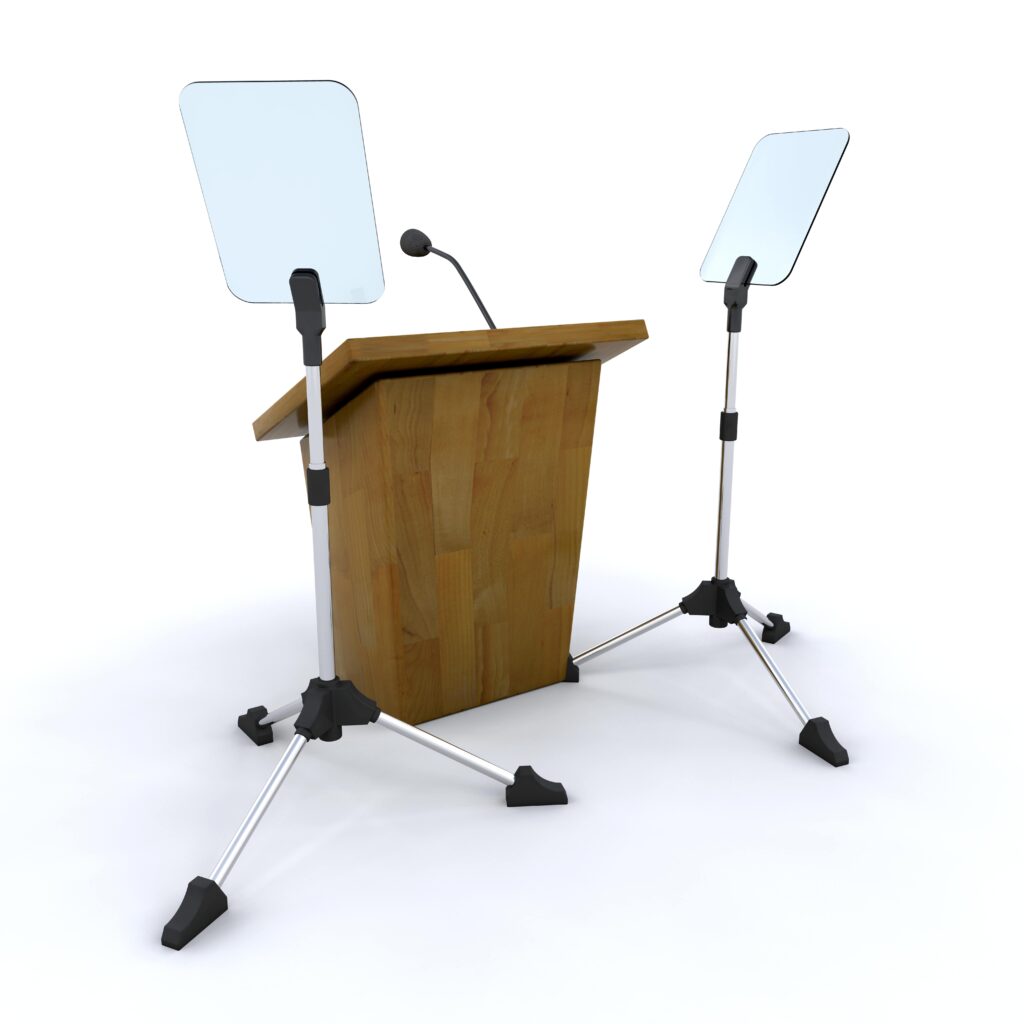In this Article...quick links
- What is an autocue?
- The Three Main Types of Autocue
- How Is Presenting Using Autocue From A Script Different To Presenting From Short-Hand Notes?
- How To Write An Effective Script for Autocue
- Benefits of using an autocue
- The disadvantages of using autocue
- Develop your executive style and build confidence through training or 1-to-1 coaching.
This time of the year is typically buzzing with industry conferences. Many of us will be attending one or more conferences, or perhaps even speaking at, or participating in, a conference event. Each conference season we provide tips and training that cover some of the most important, and useful, aspects of speaking at a conference, like for instance, managing a panel discussion. In this blog we are going to focus on how to use an autocue effectively, including how to craft the right script, tips for ensuring a flawless and engaging delivery and some of the many pitfalls to watch out for.
What is an autocue?
An autocue or as it was originally known, a teleprompter, is a display screen or visual that shows electronic text to aid a speaker or presenter with a script or speech. Autocues are used primarily in film productions, TV studios and public speaking events. The prompter allows the speaker to read the pre-written speech whilst maintaining eye contact with their audience. Over time there have been many variations of an autocue here are the top three.
The Three Main Types of Autocue
Invented in 1948 by Hubert Schlafly the Teleprompter, or autocue as most of us now know it, has evolved into three main types.
-
Presidential Autocue
This is the autocue of choice for large venue events and is widely used by politicians, hence the name. The script is projected onto a two-way mirror in front of the speaker, and the camera if there is one. This enables the speaker to read the text whilst still looking directly at the audience or camera. It can be floor mounted or attached to the podium.
-
Camera-Mounted Autocue
Camera-mounted autocues are much smaller and are attached directly onto the camera, usually a video camera, and can be operated remotely via a laptop or tablet.
-
Stand Autocue
A less discreet option, these are designed for smaller conference venues, boardrooms. And the like. This consists of a monitor that is mounted on a stand in front of, or slightly to the side of, the speaker. You often find them on the floor in front of the podium, tilted up towards the speaker.
…and there are others too…
In addition, there are a number of autocue apps like Parrot Teleprompter that have been developed allowing users to project the script onto a tablet or smartphone negating the need for expensive equipment.
But before we get to the nitty-gritty of how to use an autocue, the most important piece of advice we can give you is to think very carefully before you say yes to using one in the first place. It is a real skill and one that takes a great deal of practise to master.
How Is Presenting Using Autocue From A Script Different To Presenting From Short-Hand Notes?
The first thing to consider is that when you’re presenting from autocue using a script, your brain will automatically switch from speaking mode to reading mode. And when we’re in reading mode, the voice usually becomes very monotone and boring to listen to. Not only that, but when you’re using an autocue, and reading your script, it only shows a few lines at a time. It’s not like when you’re reading from a sheet of paper and you’re able to see the whole page with many more lines of your script in front of you. This means that with an autocue you can quickly lose where you’re at in the narrative as your words almost lose their meaning. So, counter-intuitively, knowing your script intimately becomes even more important when you’re using autocue, not less so!
The second thing to note is about speeding! When we’re in reading mode, we generally speak quicker than normal, and we forget to pause. The autocue technology can help us with this, though, as you can set the speed at which your script scrolls, through either a hand-held device or using a pre-set mode. At larger venues, the speed may even be controlled by someone else off-stage – who you can ask to help set the right speed for you.
Finally, because of the inclination with autocue to be in reading mode, you need to include directions, within your script, for how to speak at certain points during your presentation, as well as instructions for when to use other technology e.g. slides.
How To Write An Effective Script for Autocue
First and foremost, you need to keep the script conversational.
This is easier said than done because we all tend to write more formally than we speak. For example, we include more elaborate vocabulary, and use longer, more complicated sentence constructions, than we usually would when talking.
The trick is to make your script sound as though you are simply having a chat with the audience. And the way to know if you’re succeeding with this aim, is to read the script out loud, ideally to a colleague or friend, so they can give you feedback and advice. Or record yourself (on your phone, for example) and then listen back to the recording imagining you are a person in the audience.
Once you have the essence of the script nailed, you want to add your own speaking directions to it.
Speaking directions can include:
- PAUSE – after an important point so that it fully lands with the audience
- UNDERLINE – certain words to add extra emphasis to them so they stand out
- OPEN GESTURE – to bring the audience into the story
- SLOW – when you get to a more complicated part of the story
- SMILE – to lighten the mood or heighten audience engagement
- MOVE – to add energy and animation to your style
- CHECK-IN – to remind yourself to ask if the audience has any questions
When you get the hang of including speaking directions, they can be incredibly helpful in prompting you to use both your voice and body language to bring your story to life for your listeners.
Of course all the usual presentation rules still apply:
- Start with an attention grab
- Use storytelling techniques
- Simplify your ideas so that you emphasise the core messages
- Involve the audience where you can
- Use simple, impactful slides to enhance and dramatise the message.
Refine your script until you are happy with how it sounds.
Finally, add any other instructions that you’ll need e.g. CHANGE SLIDE, PLAY VIDEO, HAND TO ANOTHER SPEAKER etc. And, as silly as it sounds, it’s always a good idea to include STOP at the end so you don’t accidently move to a blank slide when you finish.
NOTE: Importantly, make sure your directions and instructions stand out, either by putting them in bold, or capitals or on their own lines in brackets. This is to ensure you don’t read them out loud by mistake!
Benefits of using an autocue
If you’re a nervous presenter then the autocue may help you as you don’t have to memorise your script and, as long as you’re very familiar with it, it can be a good way to make sure you consistently deliver the message as it was intended.
It doesn’t remove the need to practise though! Rehearsing your script is crucial to ensure that you sound confident, relaxed and in control. Practise will also help make sure you remember the points below:
Things To Remember
- Make regular eye contact with the audience. It’s something you would do naturally without a script so don’t forget to look up and around. If you know your content well enough this should be fairly easy to incorporate.
- Speak naturally and slowly. As we’ve already said, having the words in front of you can make you inadvertently speed up, so keep an eye on your pace.
- Use hand gestures and body language cues in the same way you would in a conversation.
- Remember to vary the pace and tone of your voice to reflect and emphasise the content. If you haven’t read our blog on how to present with gravitas then check it out. It has some great tips on delivery.
- Practise with the script and the autocue in advance of the event. If you don’t have access to one, download one of the Apps and practice with that. The more comfortable you are with the format the more you can concentrate on your performance. And importantly, during your practise, make sure your presentation is the right length – never go over your allocated time.
- On the day of the event, arrive early so you can make sure the speed (and things like font/size settings) are right for you. If you can, practise using the autocue so you feel 100% comfortable with it.
- Remember, the autocue is there to make your life easier, so don’t forget to relax and smile!
The disadvantages of using autocue
We always try to stay positive with our advice, but unfortunately there are probably more pitfalls to watch out for with a topic about autocues than usual. The more you are aware of what can go wrong the better you will be equipped to deal with it on the day. Here are some of the key disadvantages of using the autocue:
-
Being at the mercy of technology
If you have only practised your speech with the autocue then a technical glitch on the day can really throw you. Make sure you have a full printout of your speech and practice with this as well in case you have to revert to a hard copy.
-
Being out of sync with the human autocue controller
Similarly, if someone else is operating the autocue then make sure you rehearse with them in advance. Establish some signals that will indicate if you need to speed up, slow down or pause.
-
Being inflexible and lacking spontaneity
Both can be compromised if you become too reliant on the autocue and fail to pick up on audience cues and reactions. Ted Talkers rarely use an autocue for this reason. It’s easy to slip into a mono-toned robotic delivery and lose sight of the mood in the room. You need to be comfortable enough with the technology to allow for unplanned interruptions.
-
Being unable to stray from the script
It’s difficult to adlib or add an extra point because the prompter is moving at a fixed speed. Improvisation becomes very difficult unless you are a real pro with the technology.
-
Being detached from your audience
Failure to connect with the audience is probably the biggest potential pitfall when using this technology. You may feel more comfortable having the script in front of you but it becomes very easy to stare at it for extended periods and ignore the audience in front of you. It is crucial that you regularly look-up at the audience, maintain eye connection and work hard at keeping the audience engaged.
-
Being a speeder!
Getting ahead of yourself. If you start to read faster than the autocue then you will be left with awkward pauses, in the wrong places, while you are waiting for it to catch up. Try to stay synchronised with the speed.
-
Being inanimate
Don’t stay static, and fixated on the autocue. If you are incorporating other technology such as slides or video then remember to shift position, point and interact with the visual aids to reference important messages and content (and therefore increase audience engagement).
-
Being overconfident or lazy
Don’t fail to practise sufficiently. This is true for any presentation but don’t be fooled into thinking that you don’t need to rehearse as much because the script is in front of you.
Practising your speech with the autocue and being mindful of the pitfalls will help you to be better prepared and deliver a more compelling speech on the day. It’s certainly not for everyone but it is definitely worth a try, especially in the privacy of your own space, to see if it is something that can work for you.
Our final tip is that you should probably focus on developing and honing your presentation skills until you are a confident and consistent presenter before you start to experiment with autocue. That way, all of the important aspects of your performance will be embedded and become second nature.
Whatever you decide, enjoy the conference season!
Develop your executive style and build confidence through training or 1-to-1 coaching.
If you’re looking for help on how to speak at a conference, for yourself, or your team, our personalised training or coaching that is tailored to your business, is just what you’re looking for!
For nearly 20 years we have been the Business Presentation Skills Experts, training & coaching thousands of people in an A-Z of global blue-chip organisations – check out what they say about our programs.
To find out more, click on one of the buttons below:
This blog is co-authored with Sonia Legg, Senior Consultant & Coach

Belinda is the Co-Founder and Managing Director of SecondNature International. With a determination to drive a paradigm shift in the delivery of presentation skills training both In-Person and Online, she is a strong advocate of a more personal and sustainable presentation skills training methodology.
Belinda believes that people don’t have to change who they are to be the presenter they want to be. So she developed a coaching approach that harnesses people’s unique personality to build their own authentic presentation style and personal brand.
She has helped to transform the presentation skills of people around the world in an A-Z of organisations including Amazon, BBC, Brother, BT, CocaCola, DHL, EE, ESRI, IpsosMORI, Heineken, MARS Inc., Moody’s, Moonpig, Nationwide, Pfizer, Publicis Groupe, Roche, Savills, Triumph and Walmart – to name just a few.





